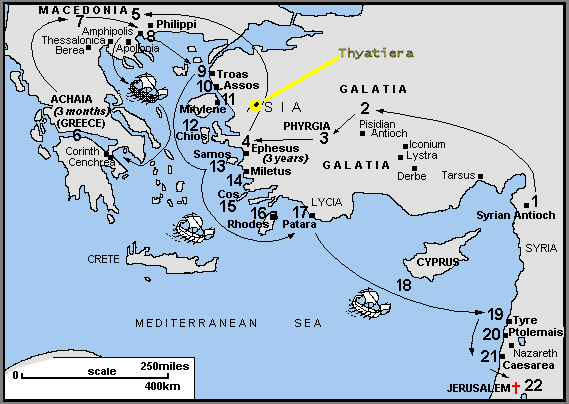The church at Thyatira allowed a woman who called herself a prophetess (the Lord did not call her one) to teach the above mentioned heresies from a position of authority. (The Letters to the Seven Churches, pg. 13).
“Thyatira was specially noted for the trade guilds which were probably more completely organized there than in any other ancient city. Every artisan belonged to a guild, and every guild, which was an incorporated organization, possessed property in its own name, made contracts for great constructions, and wielded a wide influence. Powerful among them was the guild of coppersmiths; another was the guild of the dyers, who, it is believed, made use of the madder-root instead of shell-fish for making the purple dyestuffs. A member of this guild seems to have been Lydia of Thyatira, who, according to Acts 16:14 , sold her dyes in Philippi. The color obtained by the use of this dye is now called Turkish red. The guilds were closely connected with the Asiatic religion of the place. Pagan feasts, with which immoral practices were associated, were held, and therefore the nature of the guilds was such that they were opposed to Christianity. … It was taught by many of the early church that no Christian might belong to one of the guilds, and thus the greatest opposition to Christianity was presented.”
“Thyatira,” International Standard Bible Encyclopedia.
“But the same evil practices taught in ‘the doctrine of Balaam,’ which were accepted by a few in Pergamum, were countenanced in the leadership of the church in Thyatira. Quite possibly this danger to the church involved not only a spiritual compromise with paganism but also the literal question of Christians’ attending actual feasts, such as the trade-guild banquets with their idolatrous aspects and their probable tendencies to immorality. Certain it is that such problems had been real in Paul’s day (Acts 15:20; 1 Corinthians 8; 10:20-28), and that the trade guilds, so necessary to the prosperity of the Christian craftsmen, were particularly numerous and important in Thyatira.”
LeRoy E. Froom, Prophetic Faith of our Fathers, Vol. 1, p. 93.

Leave a Reply